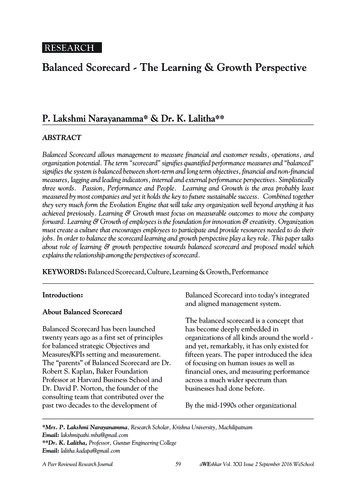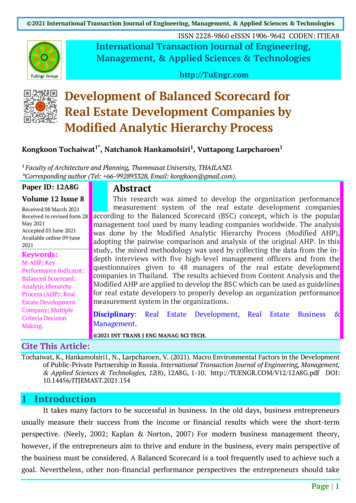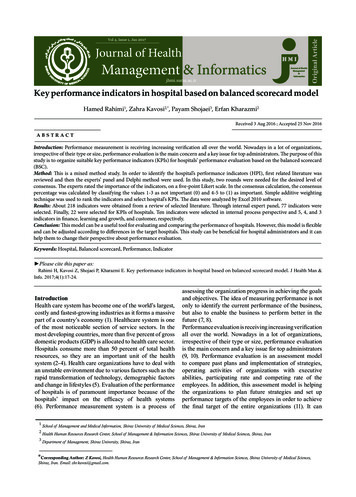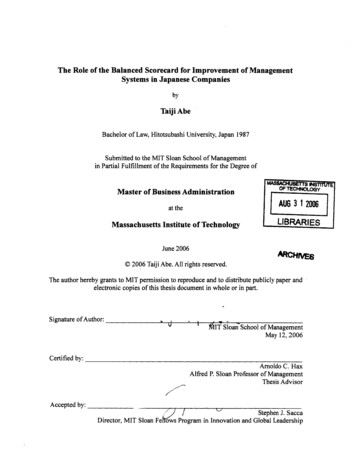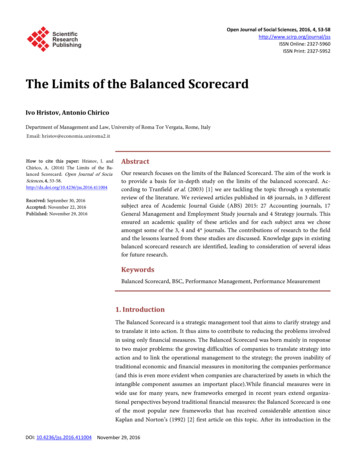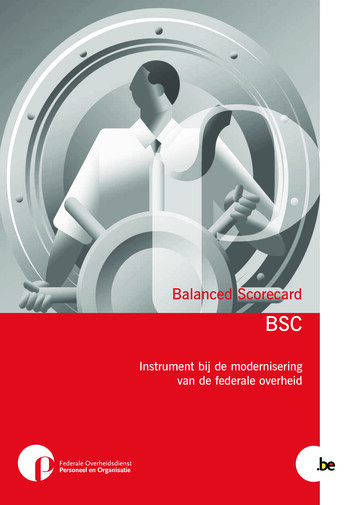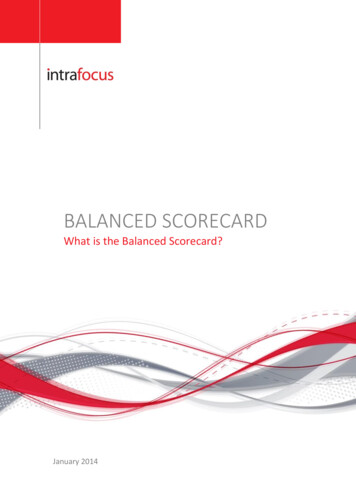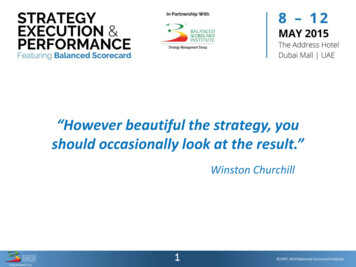
Transcription
(2021) 12:69Teichgräber et al. Insights nsights into ImagingOpen AccessORIGINAL ARTICLEDevelopment of a balanced scorecardas a strategic performance measurementsystem for clinical radiology as a cost centerUlf Teichgräber1* , Rainer Sibbel2, Andreas Heinrich1 and Felix Güttler1AbstractObjectives: To develop a goal-oriented indicator system based on the balanced scorecard (BSC) concept, whichtakes into account the perspectives of the referring physician and patient and emphasizes the focus on the internalprocesses of the radiology department.Methods: Development of a BSC occurred in six steps: (Step 1) strengths/weaknesses and opportunities/risks(SWOT-) analysis of the radiology department, (Step 2) setting-specific objectives (model, core values, key objective)followed by the development of 4 perspectives, (Step 3) and definition of strategic issues oriented to the value-addedchain of the processes of the radiology department. (Step 4) Creation of a “Strategy Map” with regard to the perspective and their cause–effect relationships. (Step 5) Development of an automated key performance indicator (KPI)cockpit for the monitoring, reporting, and management scorecard.Results: A total of 10 success factors were identified using SWOT analysis. The core values include high quality inclinical, teaching, and research areas. The radiological value-added chain is composed of three processing steps. 1.registration, 2. examination, and 3. reading/X-ray demonstration. Three action programs were derived: 1. increasecompetency (e.g., specialist standard), 2. improve referring physician/patient satisfaction, 3. increase productivity. Dailyprocess monitoring was added to the management cockpit as a monitoring scorecard. The scorecard comprises 18KPIs and is automatically updated every month. The annual management scorecard comprises 10 KPIs.Conclusions: The BSC makes it possible to implement a strategy for radiology that is strongly oriented toward therequirements of the referring physicians and the demands of patients.Keywords: Balanced scorecard, Key performance indicators, Controlling, Radiology, Management cockpitKey points The implantation of a Balanced Scorecard conceptin radiology represents a strategic management tool,which takes into account the perspectives of thereferring physician and patient and emphasizes onthe internal processes of the radiology department.*Correspondence: ulf.teichgraeber@med.uni-jena.de1Institut für Diagnostische und Interventionelle Radiologie, UniversityHospital Jena, Friedrich-Schiller-University, Am Klinikum 1, 07747 Jena,GermanyFull list of author information is available at the end of the article Focusing on the value-added chain of the radiologydepartment (process orientation) represents the fundamental idea of Balanced Scorecard for radiology. Balanced Scorecard based monitoring can help toovercome the weaknesses of a traditionally budgetoriented reporting system.IntroductionRadiology departments in a hospital function as acentral internal cost center for other clinical departments and clinics (profit centers), such as the internal The Author(s) 2021. Open Access This article is licensed under a Creative Commons Attribution 4.0 International License, whichpermits use, sharing, adaptation, distribution and reproduction in any medium or format, as long as you give appropriate credit to theoriginal author(s) and the source, provide a link to the Creative Commons licence, and indicate if changes were made. The images orother third party material in this article are included in the article’s Creative Commons licence, unless indicated otherwise in a credit lineto the material. If material is not included in the article’s Creative Commons licence and your intended use is not permitted by statutoryregulation or exceeds the permitted use, you will need to obtain permission directly from the copyright holder. To view a copy of thislicence, visit http:// creat iveco mmons. org/ licen ses/ by/4. 0/.
Teichgräber et al. Insights Imaging(2021) 12:69medicine, surgery, or emergency departments. Asa rule, a radiology department usually is defined asa clinical institution with its own budget and costresponsibilities without its own wards (hospital beds)or outpatient clinics [1, 2]. Radiological services arereimbursed through internal service accounting. Thecurrent reporting system for radiology comprises acost- and revenue-based system of indicators basedon annual budgets. The planning and management ofservices provided are based solely on cost and revenueelements.While the revenue side is closely related to the typeand number of examinations performed, the coststructure in a radiology department is characterizedby high personnel costs (as is typical for hospitals) onthe one side and high technology-related, fixed costson the other. Smooth organization of the processeswith respect to personnel deployment, patient waitingtimes, and diagnosis ensures effective cooperation withrequesting and referring clinics as well as the efficiencyof the department. Therefore, the focus of managementin the radiology department and the greatest optimization potential is in the design and organization ofwork processes. Traditional reporting in the radiologydepartment does not consist of special measured valuesand key performance indicators (KPIs) that documentand evaluate the work processes. Therefore, it is necessary to expand the current reporting system to focus onfactors such as the work processes and use of resourcesand to be able to achieve goal-directed planning andmanagement of added value for both patients and referrers as primary clients.Kaplan/Norton developed a multidimensional systemof indicators at the beginning of the 1990s known as thebalanced scorecard (BSC) to serve as a management concept for implementing strategies. BSC is a concept formeasuring, documenting, and managing the activities ofa business or an organization with regard to the implementation of its vision and strategy with the intention ofbalancing the four perspectives of the services [3]. BSCis a link between strategy development and implementation. The traditional financial strategy targets in thisconcept are added to the operational objectives relating to the client, internal process, and resource-orientedlearning and development perspectives. The entire valueadded chain in this system of indicators is presented inline with cause/effect relationships in the four targetfields (perspectives): FinancesMarket and clientsInternal business processes/work processesLearning and growth (innovation)/potentialPage 2 of 8Therefore, the perspectives should not be consideredindependently but in a hierarchical structure accordingto Kaplan and Norton [4]. Among other things, the rightbalance of the resulting system of indicators is that theobjectives and parameters that are related classically tofinancial results are related to the customer, process, andpersonnel factors and drivers that influence them significantly. Furthermore, quality-oriented “soft” success factors such as result quality, processing times, adherence toappointments, innovation, motivation, and qualificationof employees can be evaluated along with “hard” factbased KPIs.In Health Care Organizations, it becomes more important that department heads serve as strategic managerswith the ability to evaluate a changing industry, analyzedata, question assumptions, and develop new ideas [5].Kaplan and Norton also concerned themselves withthe implementation of the BSC concept in nonprofitorganizations (NPOs) and have published several casestudies on this topic [6]. They determine that too littleattention is paid to the intended output during strategydevelopment. Hospitals in Germany also are operatedpredominantly as public law corporations or nonprofitcorporations. For this reason, they are also regarded asNPOs. Kaplan and Norton summarize their experiencewith NPOs as follows: “BSC projects often were builton hastily implemented quality management systemsthat aimed to improve processes. It was difficult to findan NPO that followed a strategy which included productleadership and a close association with clients” [6].To address this lack of strategy-based management,Friedag and Schmidt have developed a highly practicalapproach to implementing BSC and have extended theconcept to three consecutive scorecards (Fig. 1) [7]: A Daily Monitoring Scorecard depicts the currentperformance with the aid of process key values. A Monthly Reporting Scorecard replaces the monthlyreporting system, summarizes the most importantfinancial KPIs, adds to the internal processes (workprocesses) through use of KPIs, and links strategicmanagement with operative controlling. An annual balanced scorecard serves as the basis foran annual reporting, summarizing all perspectivesand used for strategic management.For the radiology department as the internal costcenter of the hospital, there is a large potential forimprovement both in the sense of quality and the costefficiency of internal processes. Therefore, internal monitoring of work processes (e.g., determining examinationtimes, headways, patient waiting times, examination revenue) offers itself as an addition to the report and annual
Teichgräber et al. Insights Imaging(2021) 12:69Page 3 of 8Fig. 1 Deriving the scorecards from the four key perspectivesbalanced scorecards. Daily monitoring is conducive tooperative management of the department. The results ofprocess monitoring are included in the report and annualbalanced scorecards in an aggregate form.MethodsThe development of the BSC for the radiology department at our university hospital and its service portfoliooccurred over six steps (Fig. 2): (Step 1) The first stepincluded a strengths/weaknesses and opportunities/risks(SWOT-) analysis for internal and external current stateanalysis of the radiology department as a cost centerwithin the university hospital with regard to internal andexternal influencing factors and changes. The SWOTmatrix below presents the opportunities and risks analyzed in relation to identified strengths and weaknessesto define the limits for subsequent, long-term-orienteddepartmental strategy.The second implementation step involved determining and defining the vision and the specific strategicFig. 2 Process steps to create a balanced scorecard for the radiology department
Teichgräber et al. Insights Imaging(2021) 12:69objectives for the radiology department (model, fundamental values, key objective). The derivation of the keyobjective was performed through analyses of uniqueness,target clients, and the needs of their clients. The thirdimplementation step was the development of four perspectives of the BSC design as well as the strategic areasof activity in the perspectives. The classical hierarchicalarrangement of the perspectives according to Kaplan/Norton was modified in terms of the environment andfor use in the radiology department. Instead of the financial perspective, the client perspective in terms of a costcenter and the medical result dimensions was chosen asthe highest hierarchical level. Unlike other clinical institutions in the hospital, the radiology department servestwo categories of clients: patients and clinical referrers(other clinics within the hospital). We grouped both client categories as part of the client perspective, creatingthe patient and referrer perspective. This was then followed by the financial perspective, the internal processperspective and, finally, the employee perspective.Strategic themes for each level based on this BSCstructure were defined and oriented on the value-addedchain of the processes in the radiology department. Theradiological value-added chain consists of three basicprocess steps: 1. patient registration and the requestedexamination, 2. realization of the examination, and 3.Fig. 3 Strategy map of the radiology departmentPage 4 of 8findings/X-ray demonstration. Important time-dependent measured values in terms of process efficiency linkedto these core processes were identified in a subsequentimplementation step; these are closely linked to qualityand profitability requirements on the client and financiallevels.The focus of the fourth implementation steps was thecreation of a strategy map (Fig. 3), which presents thecause/effect relationships below between the strategicareas of activity in the perspectives as well as subsequentdefinition and selection of KPIs based on the measuredvalues for each area of activity.Next, potential KPIs based on the thematic focus aswell as the area of activity regarding the other perspectives and their cause/effect relationships were identified,which could be consulted with objective-oriented assessment of each core aspect. Possible process KPIs couldbe derived, e.g., from automatically measurement timestamps from the radiological information system (RIS).In total, nine different timestamps were collected. Additional KPIs were collected through literature research.For the referrer and employee perspective, KPIs fromthe radiology department annual electronic referral andemployee survey were available.For the subsequent selection of KPIs for the BSC, aunique evaluation concept with the acronym CSTC was
Teichgräber et al. Insights Imaging(2021) 12:69developed. Based on four quality criteria, all previouslycompiled KPIs were evaluated and prioritized using anumerical ranking scale based on Concision, Surveyeffort, Topicality and Clarity. The fifth implementationstep consisted of a final selection and definition of KPIsusing a Horváth and Partner filter as well as the derivation of action programs [8]. In the sixth implementationstep, the KPI cockpit for the monitoring, report, andannual balanced scorecard was created. The respectivescorecards should be created completely automaticallyand be viewed at any time over a web portal. The annualbalanced scorecard and the monthly reporting scorecardshould be updated monthly and daily internal processmonitoring pursued.ResultsSWOT analysis resulted in a complete picture of the current situation as well as the important challenges for thehospital and the radiology department as a basis for strategic planning (Table 1). From this, a total of 10 successfactors for a sustainably successful strategic positioning could be identified. Radiology as a cost center wasdefined as a departmental model. The fundamental values include high quality in clinical, teaching, and researchareas. The vision, as well as the key objective in the longterm, is to be in the top 10 in terms of innovation and services amongst German university radiology departments.The strategic issues discussed are part of the value-addedPage 5 of 8chain of the radiological work processes and are also themost important performance drivers. From the strategymap along with a systematic literature analysis, 34 KPIscould be extracted for the radiology department and theCSTC evaluation conducted. The number of KPIs forthe monthly reporting scorecard could be reduced to 18using the Horváth and Partner filter. As a result, threeaction programs for the radiology department were created. 1. increase in competency (specialist standard,MTRA training), 2. improvement in referring physician/patient satisfaction, 3. increase in productivity daily process monitoring was added to the management cockpitas a monitoring scorecard. The monthly reporting scorecard consists of 18 KPIs and is automatically updated ona monthly basis. The annual management scorecard comprises 10 KPIs, each of which has a KPI from the annualelectronic employee and referrer survey (Table 2).DiscussionMainline for-profit companies accepted BSCs in themeantime, but non-for-profit healthcare organizationswere slow to adopt them for use. A number of problemsface the healthcare industry, including cost structure,payor limitations and constraints, and performance andquality issues that require changes in how healthcareorganizations, both profit and nonprofit, manage operations [9]. Already in 1998, Sahney demonstrated anTable 1 Strengths/weaknesses and opportunities/risks (SWOT-) analysisStrengthsWeaknessesInternal analysisCost center for all radiological services within hospitalWide range of additional training with complete training authority andadditional designations for neuroradiology and pediatric radiologyLack of specialists, unfavorable ratio of young professionals to specialistsduring trainingHigh workload for the medical staffLong waiting times for examination appointmentsLong processing timesModern organizational management with department system that has amatrix structureCommunication deficits with internal referrersNo hospital beds in department for interventional radiological proceduresHighly specialized MRI and IR servicesEstablished research section for MRI physics, experimental radiology, andmedical engineeringOpportunitiesRisksExternal analysisOnly university radiology department in the regionGood public image through symposiums and congresses (regional,national, and international presence)Specialized diagnostic examinations and minimally invasive procedures areunique selling pointsModern instrumentationCompetition through expansion of other hospitals into highly specializedservicesGood PR work through radiological CME events at other hospitalsLacking radiological medical care center for ambulatory servicesMost modern equipment in hospital for general and standard careCME: continuing medical education, IR: interventional radiology, MRI: magnetic resonance imaging, PR: public relations
Teichgräber et al. Insights Imaging(2021) 12:69Page 6 of 8Table 2 Annual management scorecard for the radiology departmentAnnual balanced scorecardPerspectivesKey performance indicatorsReferrer and patient perspectiveAppointment availability Period until earliest possible appointment (Inpatients)Patient waiting time Waiting time on location (in the department)Referrer satisfaction Referrer surveyFinancial perspectiveTechnician productivity Services/costs (technicians)Registration t from request to assignment of appointmentsMedical staff productivity No. of exams/costs (staff )Process perspectiveRelease of reports t from examination to release of radiology reportPatient delay Proportion of delayed patientsEmployee perspectiveAdditional training standard Status of specialist trainingEmployee satisfaction Employee surveyapproach how to apply a BSC in managed care organizations (MGOs) for measurement, development of strategy,and performance improvement. MGOs as healthcareproviders are constantly facing the pressure of improving their financial performance in a highly competitiveenvironment [10]. One of the first implementations ofthe BSC concept in the clinical environment was initiatedby the Yale University School of Medicine in the fieldof Anaesthesiology published in 1999 demonstrating agreat value to a department, even if the full implementation takes several years to complete [11]. In differenthealthcare sectors, the BSC concept is applied to supportimproved decision making and performance [12–17].In order to attain a useful BSC in the healthcare sector,appropriate performance perspectives and indicators arecrucial to reflect all strategies of the organization. It alsorequires medical staff to contribute in BSC development,which will result in greater reliability of the BSC [18].In peer-reviewed journals in the medical field, therehave only been two studies published on the applicationof BSC in a radiology department. An article from Maueret al. presents a conceptual BSC for an academic university radiology department with focusing on teaching andresearch [19]. In this study, additional KPIs for teachingevaluation and examination grades were added to patientand referrer satisfaction from the client perspective.Additionally, five additional perspectives were suggestedas a scientific perspective, which takes into considerationscientific publication output (number, impact factor) andthe external funding secured. Academic university hospitals are often expected to excel in multiple domains:quality improvement, patient safety, education, research,administration, and clinical care [20]. The considerationof teaching and research in university medicine appearsto be implied. In our present BSC, these important coretasks of the university radiology department have beenignored for the time being. Instead, the focus was placedon the clinical work processes to guarantee clarity andto limit where possible the number of KPIs in the BSC.In addition, at our university hospital, there is separateaccounting for cost centers/budgets between clinicalpatient care and teaching and research. For that reason,it does not appear to make sense at present to take teaching and research into account in the same BSC. Rather,a second independent report and annual BSC should beestablished for teaching and research in parallel.Donnelly et al. [21] present a case study for a BSC fora radiology department in a children’s hospital in theUS Midwest. In this BSC, 33 KPIs in six perspectiveswere identified and designated as the department scorecard. The six perspectives are clinical service, teaching, research, patients, financial, and referrers. The BSCis created every quarter and available to all employeesthrough an internet portal. It should be noted that theauthors provided no cause–effect relationships betweenthe KPIs. No information about the perspective hierarchycould be determined. The authors believe that the transparency of the KPIs for employees is essential to its use.They believe there is a motivation factor in the BSC forthe employees, which is more effective than a financialincentive. The authors believe that establishing the BSCis an important instrument for quality improvement. Theauthors have noted improvement in 61% of KPIs, consistency in 33% of results, and a decline in only 6% of resultsover the 7 years since the implementation of the BSC[21].The BSC concept allows for the development andimplementation of a strategy for the radiology department, which is closely aligned with the requirements ofthe referring in- and outpatient clinics on the department as a cost center and considers patients to be thetrue clients. The BSC makes available a new management
Teichgräber et al. Insights Imaging(2021) 12:69instrument for the radiology department of the JenaUniversity Hospital with a measurable target not onlyto use existing potential efficiently but also to developnew potentials. The methodology of our BSC used andadjusted for the radiology department is not a cookbookrecipe that can be used immediately for other clinicalinstitutions and should always be adjusted methodicallyto align with the mission and the vision of each institution or hospital. Focusing on the value-added chain of theradiology department (process orientation) representsthe fundamental idea of BSC for radiology. This approachcan serve as a guide for other radiology departmentsat other hospitals when establishing a BSC. IndividualKPIs can also certainly be used without modification. Inthese cases, it should be tested whether these align withthe strategy and success factors of each institution. It isnot recommended to simply adopt KPIs even within thesame specialization.After the implementation of our BSC, the different KPIs were used and accepted in different ways. Theprocess KPIs showed their effect in daily monitoring.In addition, these process KPIs are made available tothe internal referring clinical departments in monthlyreports for the use of radiological services. KPIs such asthe waiting time for examination appointments or radiological reports are the focus of interest. The annual BSCis used exclusively for the business planning and servesas an overview for the board of directors of our hospitalfor the operational results of the radiology department.For the personnel requirement calculation, the total performance figures, the utilization of the devices, and theminute-by-minute staff retention time of radiologists andtechnicians are used.A strategic situation analysis including defining longterm-oriented objectives should always be the first stepbefore defining KPIs for a BSC. The selection of KPIsshould be conducted in reference to set-thematic focusesand a quality evaluation that also takes into account thesurvey effort and consequent practical feasibility forKPIs. An important stipulation when establishing a BSCfor the Jena University Hospital radiology departmentwas that a paper-based survey of KPIs would not beused. The KPIs survey should be completely automated.The results of the BSC would be communicated througha web portal in an electronic management cockpit. Thatensured that the survey for the BSC in the radiologydepartment would not and will not require additionalpersonnel from the management division. At Jena University Hospital, the process and financial KPIs are allgenerated fully automatically via database queries. TheHuman Resource department data, on the other hand,must still be entered manually. In our experience, theseKPIs are unfortunately not regularly updated, such as thePage 7 of 8level of illness. As a result, the personal KPIs can onlybe meaningfully evaluated within the framework of theannual BSC. This clearly shows how important automaticdigital data transmission is for a BSC in order to use iteffectively as a management tool.ConclusionsOverall, this example of the radiology department showsthat BSC-based monitoring can also help hospitals toovercome the weaknesses of a traditionally budget-oriented reporting system and to be able to use differentscorecards to meet the different requirements of a goaloriented strategic and operational management.AbbreviationsBSC: Balanced scorecard; CSTC: Concision, survey effort, topicality and clarity;KPI: Key performance indicator; MRI: Magnetic resonance imaging; SWOT:Strengths/weaknesses and opportunities/risks.Authors’ contributionsUT is responsible for study conception and design and analysis and interpretation of data. All authors drafted or revised the manuscript, have read andapproved its final version, and are accountable for all aspects of the paper. Allauthors read and approved the final manuscript.FundingOpen Access funding enabled and organized by Projekt DEAL. This researchdid not receive any specific grant from funding sources in the public, commercial, or not-for-profit sectors.Availability of data and materialsThe data are included in the manuscript.DeclarationsEthics approval and consent to participateNot applicable.Consent for publicationNot applicable.Competing interestsThe authors declare that they have no competing interests.Author details1Institut für Diagnostische und Interventionelle Radiologie, University HospitalJena, Friedrich-Schiller-University, Am Klinikum 1, 07747 Jena, Germany.2Frankfurt School of Finance, Frankfurt School of Finance and Management,Institute for International Health Management, Sonnemannstrasse 9‑11,60314 Frankfurt am Main, Germany.Received: 1 January 2021 Accepted: 5 May 2021References1. Muchantef K, Forman HP (2005) Cost accounting in radiology: new directions and importance for policy. AJR Am J Roentgenol 185:1404–14072. Donnelly LF, Lee GM, Sharek PJ (2018) Costs of quality and safety in radiology. Radiographics 38:1682–16873. Kaplan RS, Norton DP (1992) The balanced scorecard–measures thatdrive performance. Harv Bus Rev 70:71–79
Teichgräber et al. Insights Imaging4.5.6.7.8.9.10.11.12.13.14.(2021) 12:69Kaplan RS, Norton DP (1996) Translating strategy into action—the balanced scorecard, 1st edn. Harvard Business Review Press, BostonGinter PM, Duncan JW, Swayne LE (2018) Strategic management ofhealth care organizations, 8th edn. Wiley, New YorkKaplan RS, Norton DP (2000) The strategy-focused organization: howbalanced scorecard companies thrive in the new business environment.Harvard Business Review Press, BostonFriedag HR, Schmidt W (2000) My Balanced Scorecard: das Praxisbuchfür Ihre individuelle Lösung, 1st edn. Haufe Mediengruppe Freiburg inBreisgau, BerlinHaPM C (2020) Controlling concept—the: cornerstone of performancemanagement, 1st edn. World Scientific Publishing, SingaporePink GH, McKillop I, Schraa EG, Preyra C, Montgomery C, Baker GR (2001)Creating a balanced scorecard for a hospital system. J Health CareFinance 27:1–20Sahney VK (1998) Balanced scorecard as a framework for driving performance in managed care organizations. Manag Care Q 6:1–8Rimar S, Garstka SJ (1999) The “Balanced Scorecard”: developmentand implementation in an academic clinical department. Acad Med74:114–122Fields SA, Cohen D (2011) Performance enhancement using a balancedscorecard in a Patient-centered Medical Home. Fam Med 43:735–739Yeh TM, Lai HP (2015) Evaluating the effectiveness of implementing quality management practices in the medical industry. J Nutr Health Aging19:102–112Demartini C, Trucco S (2017) Are performance measurement systemsuseful? Perceptions from health care. BMC Health Serv Res 17:96Page 8 of 815. Wu X, Li S, Xu N, Wu D, Zhang X (2019) Establishing a balanced scorecardmeasurement system for integrated care organizations in China. Int JHealth Plann Manag 34:672–69216. Harvey HB, Sotardi ST (2018) Key performance indicators and the balanced scorecard. J Am Coll Radiol 15:1000–100117. Catuogno S, Arena C, Saggese S, Sarto F (2017) Balanced performancemeasurement in research hospitals: the participative case study of ahaematology department. BMC Health Serv Res 17:52218. Behrouzi F, Shaharoun AM, Ma’aram A (2014) Applications of the balanced scorecard for strategic management and performance measurement in the health sector. Aust Health Rev 38:208–21719. Maurer MH, Teichgraber U, Kroncke TJ, Hamm B, Lemke AJ (2012) Thebalanced scorecard–applications in a radiology department. Rofo184:1118–112520. Hwa M, Sharpe BA, Wachter RM (2013) Devel
A Daily Monitoring Scorecard depicts the current performance with the aid of process key values. A Monthly Reporting Scorecard replaces the monthly reporting system, summarizes the most important nancial KPIs, adds to the internal processes (work processes) through use of KPIs, and links strategic management with operative controlling.
